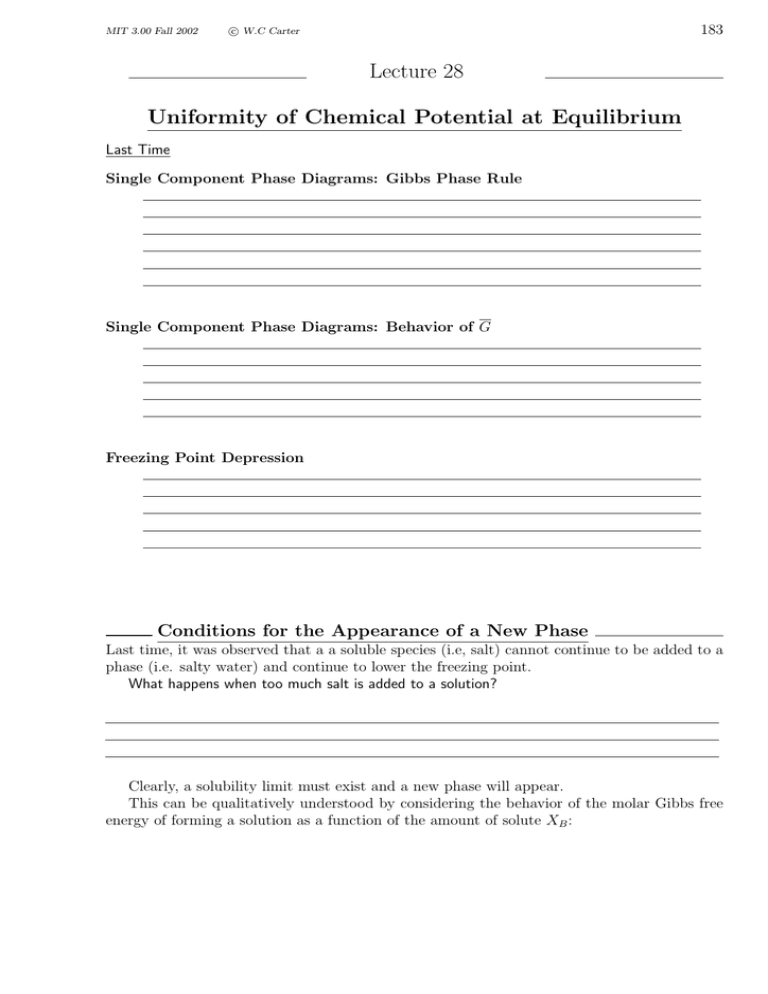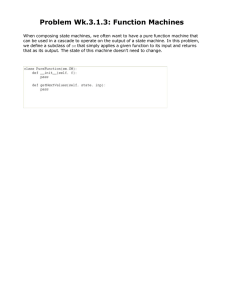Lecture 28 Uniformity of Chemical Potential at Equilibrium
advertisement

MIT 3.00 Fall 2002 183 c W.C Carter ° Lecture 28 Uniformity of Chemical Potential at Equilibrium Last Time Single Component Phase Diagrams: Gibbs Phase Rule Single Component Phase Diagrams: Behavior of G Freezing Point Depression Conditions for the Appearance of a New Phase Last time, it was observed that a a soluble species (i.e, salt) cannot continue to be added to a phase (i.e. salty water) and continue to lower the freezing point. What happens when too much salt is added to a solution? Clearly, a solubility limit must exist and a new phase will appear. This can be qualitatively understood by considering the behavior of the molar Gibbs free energy of forming a solution as a function of the amount of solute XB : 184 c W.C Carter ° MIT 3.00 Fall 2002 To quantify the conditions for the appearance of new phases, consider the thermodynamics of binary (i.e. two component) alloys28 The Gibbs-Duhem equation of a system consisting of two components A and B is: X 0 = SdT − V dP + Ni dµi = SdT − V dP + NA dµA + NB dµB Consider a closed system consisting of one mole of molecules: NA + NB = 1 mole: XA = NA NA + NB =⇒ XB = 1 − XA = NB NA + N B (28-1) The state of the system (per mole) should be representable by three independent parameters, (T, P, XB ) or (T, P, XA ). Therefore, using µA = µA (P, T, XB ) and µB = µB (P, T, XB ) in the Gibbs-Duhem equation: total total dT − V dP ∂µA ∂µA ∂µA + XA ( dT + dP + dXB ) ∂T ∂P ∂XB ∂µB ∂µB ∂µB + XB ( dT + dP + dXB ) ∂T ∂P ∂XB 0 =S where dµA = Note that 28 ∂µA ∂T = −SA and ∂µB ∂T (28-2) ∂µA ∂µP ∂µA dT + dP + dXB ∂T ∂T ∂XB = VB , thus, The notation for binary alloys uses XA and XB = 1 − XA for the composition. Because, there is only one free composition variable, sometimes people will simply use “X” to represent the amount of the second component—in our case X = XB . MIT 3.00 Fall 2002 185 c W.C Carter ° 0 =S total dT − V total dP − (XA SA + XB SB )dT + (XA VA + XB VB )dP ∂µA ∂µB + (XA + (1 − XA ) )dXB ∂XB ∂XB (28-3) The first and third terms cancel and the second and fourth terms cancel. Therefore, ∂µA ∂µB + XB =0 (28-4) ∂XB ∂XB This is a general result for binary solution. It is the form of the Gibbs-Duhem equation for solutions. Equation 28-4 gives a relation between the derivatives of the chemical potentials but not a relation between the chemical potentials themselves. (1 − XB ) Graphical Constructions for the Free Energy of Solutions A useful graphical construction can be utilized for extracting values of chemical potentials: Consider that the molar free energy of a solution is plotted as follows: — G (molar Gibbs free energy) — G °A(T,P) — (he G XA = 1 XB = 0 pure A neou teroge s mixt ur —° GA X = A e) + — X B G °B — G °B(T,P) T= constant P =constant — ∆Gmixing(T,P,XB) — G (solution) XB XA = 0 XB = 1 pure B Figure 28-1: Example of the Molar Gibbs Free Energy of a Solution and related graphical constructions. It would be particularly useful to obtain the chemical potentials of each species in solution as a function of composition. This relationship can be determined as follows: Starting with an expression for the molar free energy of the solution being a weighted sum of the chemical potentials: MIT 3.00 Fall 2002 186 c W.C Carter ° Gsol = XA µA + XB µB (28-5) dGsol becomes when using dXB = −dXA . or ∂ Gsol = µA − µB ∂XA (28-6) ∂ Gsol = µB − µA ∂XB (28-7) at constant P and T ; similarly, Multiplying ∂ Gsol /∂XB by XB and subtracting it from Gsol : Gsol − XB ∂ Gsol = XA µA + XB µB − (XB µB − XB µA ) = µA ∂XB (28-8) or µA = Gsol + XB ∂ Gsol ∂ Gsol = Gsol − XB ∂XA ∂XB ∂ Gsol ∂ Gsol µB = Gsol + XA = Gsol − XA ∂XB ∂XA These equations can be interpreted with the following figure. (28-9) 187 c W.C Carter ° µA(X =XBarb ,T, P) — G T= constant P =constant — G sol.(XBarb, T,P) µB°(T,P) − µB(X =XBarb ,T, P) XBarb XAarb XB µB(X =XBarb ,T, P) MIT 3.00 Fall 2002 Figure 28-2: Illustration of how to determine the chemical potentials from a graph of G(XB ) for a binary alloy. XBarb is an arbitrary composition where the tangent construction is performed. Equilibria between Phases To calculate the equilibrium condition between several phases, the condition that the chemical potential of each component µi is the same in each phase. The graphical construction for chemical potential can be used to obtain this condition—this condition will be called the “common tangent” condition. Suppose another curve corresponding to another phase that can also form a solution of A-B is considered. Below, another graphical construction will be demonstrated that will determine the properties of stable phases. Consider two phases; to fix our ideas let one curve be the molar Gibbs free energy as a function of composition at constant pressure and temperature be for a solid solution. Another curve for the liquid solution will be added: MIT 3.00 Fall 2002 188 c W.C Carter ° — G T= constant P =constant solid liquid XB Figure 28-3: Molar Gibbs Free Energies for a liquid and solid solution at a particular pressure and temperature. Questions: 1. What is the molar free energy charge for melting pure A? For melting pure B? 2. What is the molar free energy charge for melting a solid solution at X◦ ? 3. What is the free energy charge for forming a liquid solution from X◦ moles of pure B and 1 − X◦ moles of pure A? MIT 3.00 Fall 2002 c W.C Carter ° 189 4. In the picture as it’s drawn, rank the following with respect to stability from most stable to least stable at some fixed composition. Asolid —B solid A heterogeneous mixture of pure solid A and pure solid B. Asolid —B liquid Heterogeneous mixture of pure solid A and pure liquid B. Aliquid —B solid A heterogeneous mixture of pure liquid A and pure solid B. Aliquid —B liquid A heterogeneous mixture of pure liquid A and pure liquid B. (AB)solid Homogeneous solid solution of A and B. (AB)liquid Homogeneous liquid solution of A and B. 5. Considering that G = H − T S, which curve will “move” the most as T changes? Consider the effect of lowering the temperature slightly. MIT 3.00 Fall 2002 190 c W.C Carter ° — G T= Tm (pure B) P =constant solid liquid XB Figure 28-4: Figure 28-3 drawn at a slightly lower temperature. — G Tm (pure A) < T1 < Tm (pure B) P =constant solid liquid S XL X XB Figure 28-5: Figure 28-4 drawn at an even lower temperature than Figure 28-3. Question: Which combination is the most stable in Figure 28-5? Hint: Consider that at equilibrium µA liquid = µA solid and µB liquid = µB liquid





